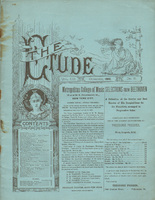While there is nothing new in the following, from the British Musician, the maxims set forth for the teacher’s guidance are well put and apply to tutors in all departments of music, and they are worth preserving.
The key to success in music teaching is to do instead of to theorize; written or oral explanation have their uses, but practical demonstration is better.
Having a general idea of a piece of music, play it to the pupil—your performance is worth all the explanations that were ever spoken or written.
Translate your verbal theory into practice; show how a scherzo differs from an adagio; how an emotion of joy differs from an emotion of pain.
To bestow correct expression, not merely the pianos and fortes, rallentandos and accelerandos, but phrasing, rhythmical feeling, and accentuation have to be noticed, and need all the care of both executant and teacher.
The art of accompanying soloists is very difficult, and many otherwise fine musicians of talent and good standing come to grief through it. Good practice in accompanying is secured by the teacher playing a solo in different styles; the accompanists will then be prepared to fall in with any conception felt by the soloist, should they be called upon to accompany a stranger.
Before placing a piece of music before a band, the teacher should study it thoroughly; make a mental (or better still a pencil) note of points where the pupils are likely to come to grief, and so be prepared to show them how to get over their difficulties.
No two pupils can be treated absolutely alike, either in a purely technical or musical sense. The teacher has to think out the artistic path for each pupil, and lead him or show him the way through it. This requires thought, and the expenditure of nervous and physical energy.
Teaching is nerve wearing. A vast amount of vital energy is constantly being expended, not only during teaching hours, but in the hours of private study and thought, which must daily be done.



